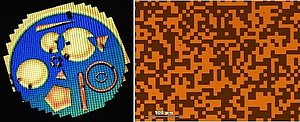MEASUREMENTS OF OPTICAL PHASE USING METHOD OF CODED DIFFRACTION PATTERNS AND NON-CONTACT PROFILOMETRY: AN INSIGHT IN POST-DOCTORAL PROJECT AND INVESTMENT AND DEVELOPMENT AGENCY OF LATVIA (IDAL) PROEJCT ACTIVITIES
Varis Karitāns (ISSP UL) speaks at scientific workshop of ISSP UL Doctoral School “Functional Materials and Nanotechnologies” on March 29 at 13:00, ISSPUL, Ķengaraga street 8, 2nd floor hall.
The phase problem is well known in optics, namely, retention of intensity information while acquiring an image, but loss of phase information, which, in turn, is very important in determining the structure of an object. Recently, various numerical methods have become popular that recover lost phase information by encoding an object with a small number of binary masks and recording the intensity measurements of such encoded objects. One of the most popular methods of this kind is the method of coded diffraction patterns, also known as PhaseLift. This method requires at least 6 masks to determine the phase of the object.
This PhaseLift method for optical phase measurement is used in both the postdoctoral project and the IDAL commercialization project. Test objects and masks are created using direct writing lithography. In the post-doctoral project, this method is intended to be used to measure the structure of objects floating in the microfluidic channel. Such objects stimulate opacity of vitreous body and, once the phase of these objects has been determined, it is possible to modulate the light entering the eye to reduce effects of opacity.
The method used in the IDAL commercialization project is intended to be used for measurement of aberrations caused by atmospheric turbulence. Simulations show that the method is applicable in case of low signal to noise ratio, which means that the existing adaptive optics systems would not require to use laser guide star in astronomy and would allow the use of weak natural light sources, thus resolving the so called cone problem that limits the
